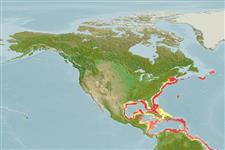>
Pleuronectiformes (Flatfishes) >
Cynoglossidae (Tonguefishes) > Symphurinae
Etymology: Symphurus: Greek, syn, symphysis = grown together + Greek, oura = tail (Ref. 45335); billykrietei: Named for Billy Kriete (former marine scientist at VIMS)..
Environment: milieu / climate zone / depth range / distribution range
Ecología
marino batidemersal; rango de profundidad 48 - 650 m (Ref. 26268), usually 201 - 380 m (Ref. 26268). Deep-water
Northwest Atlantic: off southern Nova Scotia and southward along the continental shelf of US to about Cape Hatteras, North Carolina.
Tamaño / Peso / Age
Maturity: Lm ? range ? - ? cm
Max length : 11.9 cm SL macho / no sexado; (Ref. 26268)
A deepwater fish commonly collected on mud substrates on the outer continental shelf. Little is known concerning its ecology (Ref. 26268).
Life cycle and mating behavior
Maturities | Reproducción | Spawnings | Egg(s) | Fecundities | Larva
Munroe, T.A., 1998. Systematics and ecology of tonguefishes of the genus Symphurus (Cynoglossidae: Pleuronectiformes) from the western Atlantic Ocean. Fish. Bull. 96(1):1-182. (Ref. 26268)
IUCN Red List Status (Ref. 130435)
Threat to humans
Harmless
Human uses
Herramientas
Special reports
Download XML
Fuentes de Internet
Estimates based on models
Preferred temperature (Ref.
123201): 4 - 19.3, mean 13.4 °C (based on 76 cells).
Phylogenetic diversity index (Ref.
82804): PD
50 = 0.5000 [Uniqueness, from 0.5 = low to 2.0 = high].
Bayesian length-weight: a=0.01445 (0.00647 - 0.03228), b=3.05 (2.85 - 3.25), in cm total length, based on LWR estimates for this (Sub)family-body shape (Ref.
93245).
Nivel trófico (Ref.
69278): 3.3 ±0.4 se; based on size and trophs of closest relatives
Resiliencia (Ref.
120179): Alto, población duplicada en un tiempo mínimo inferior a 15 meses (Preliminary K or Fecundity.).
Fishing Vulnerability (Ref.
59153): Low vulnerability (10 of 100).
